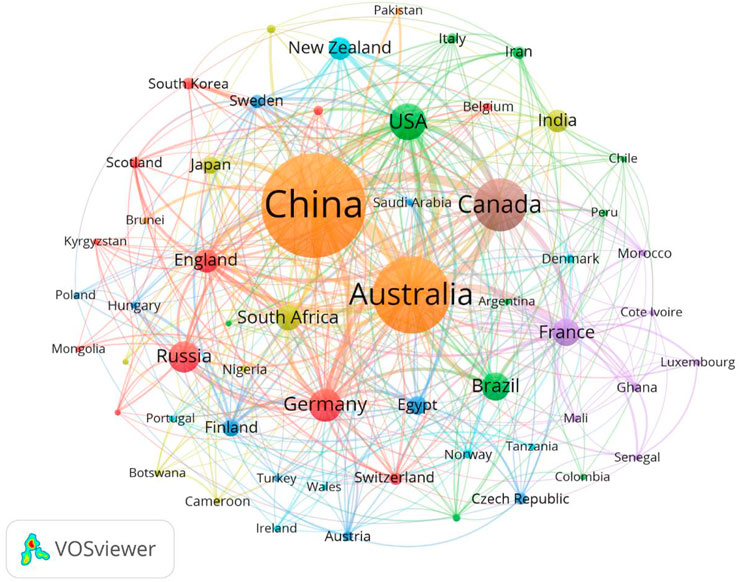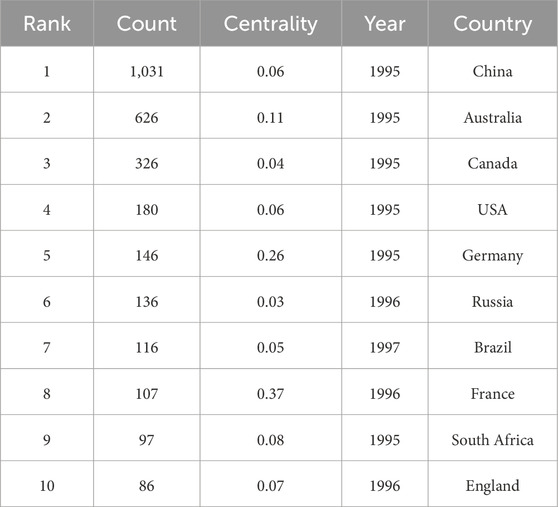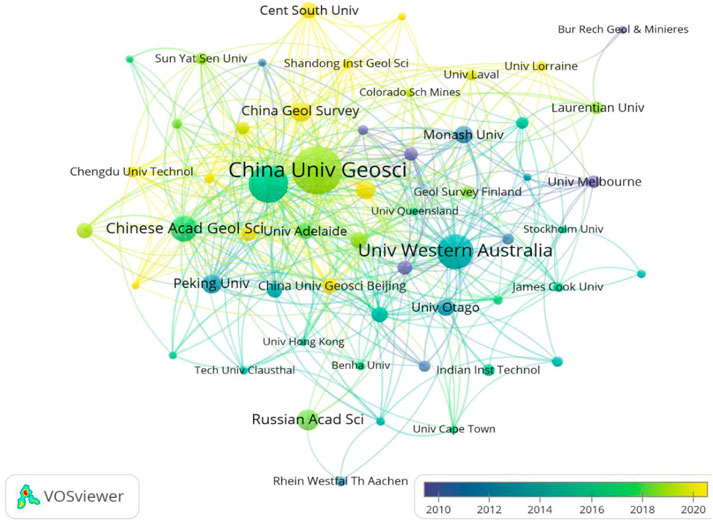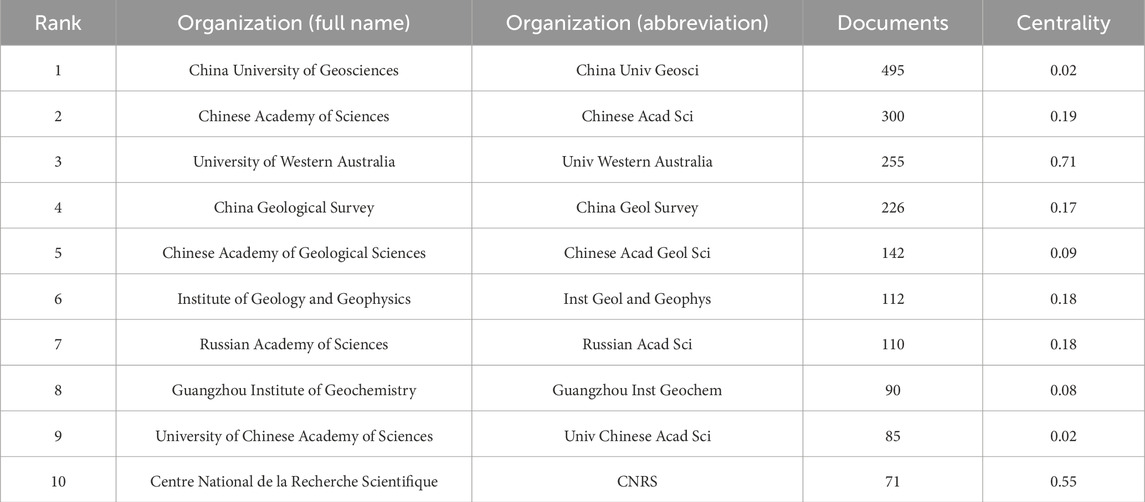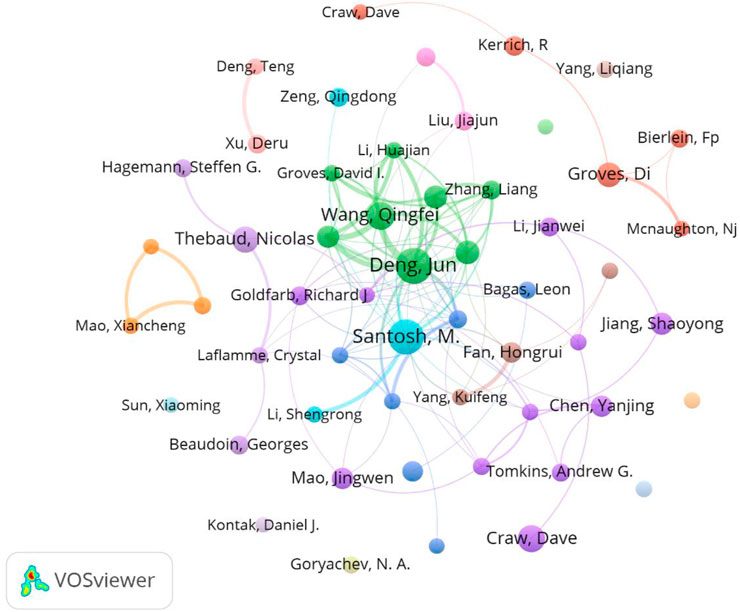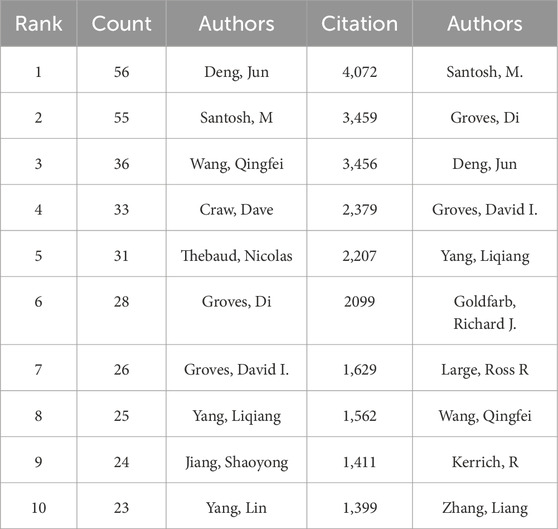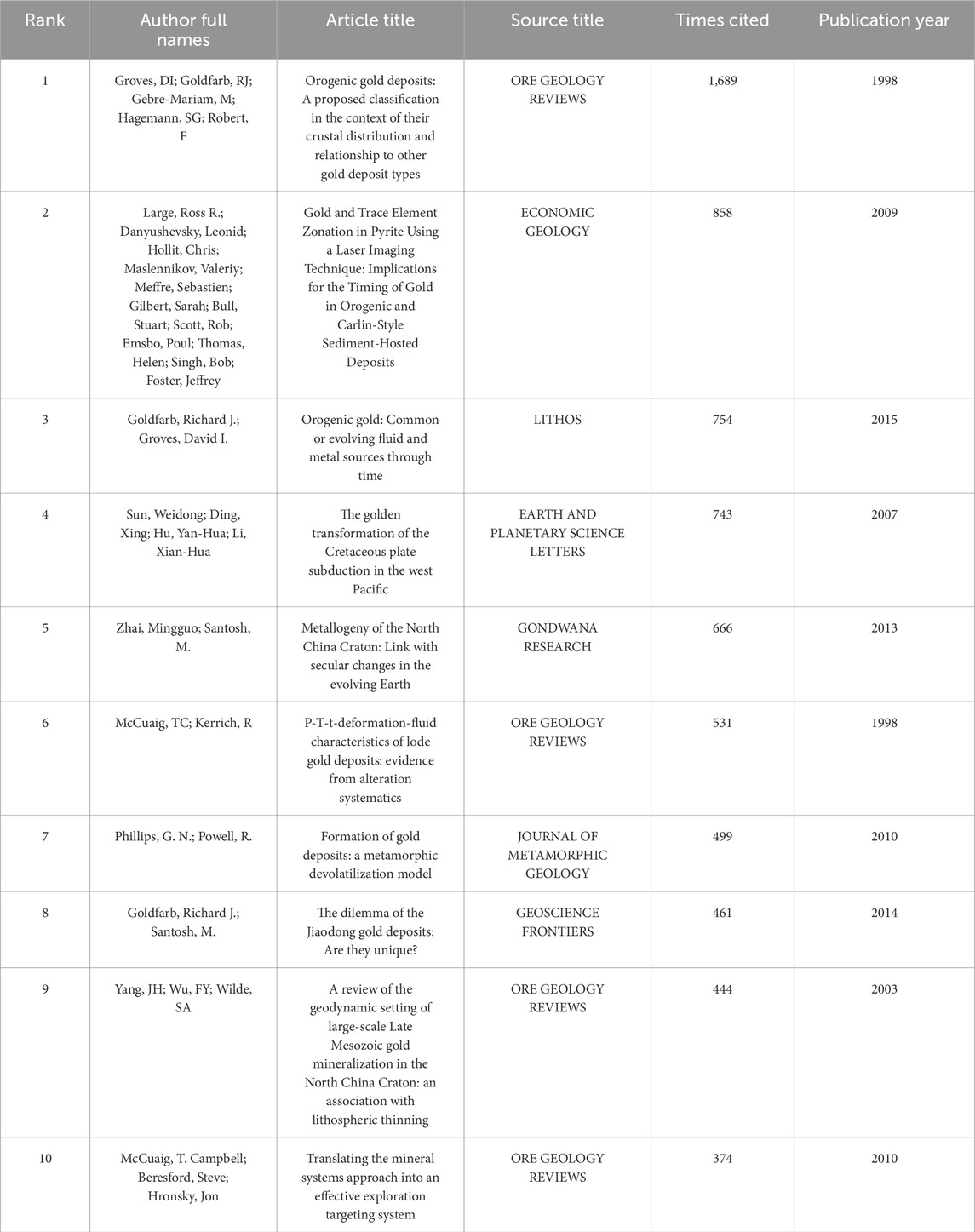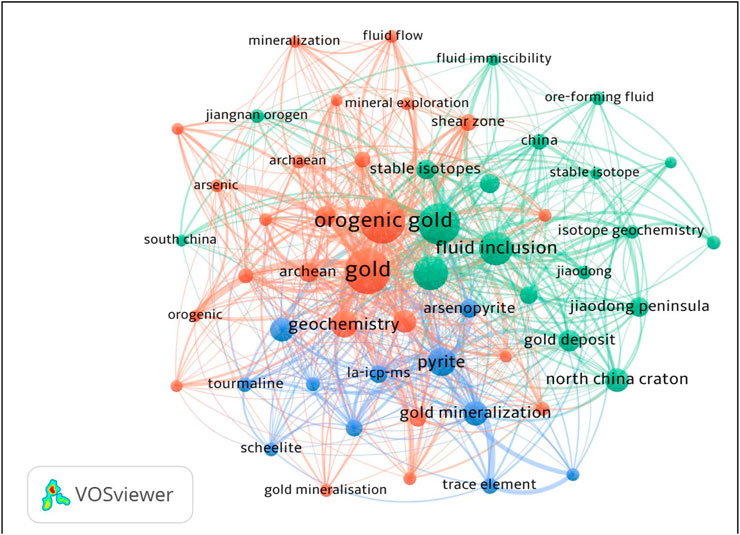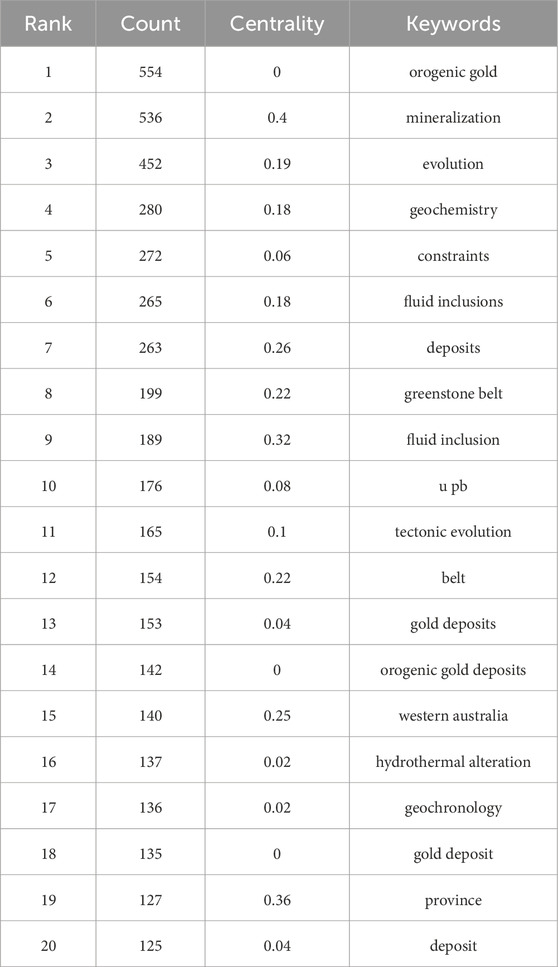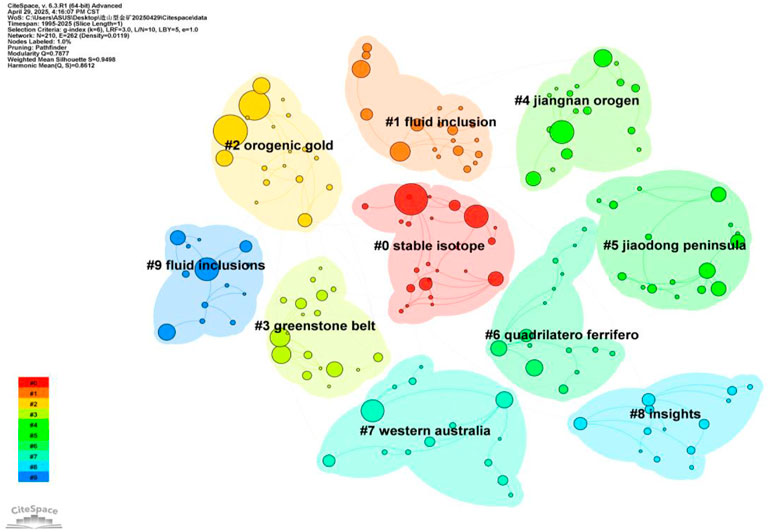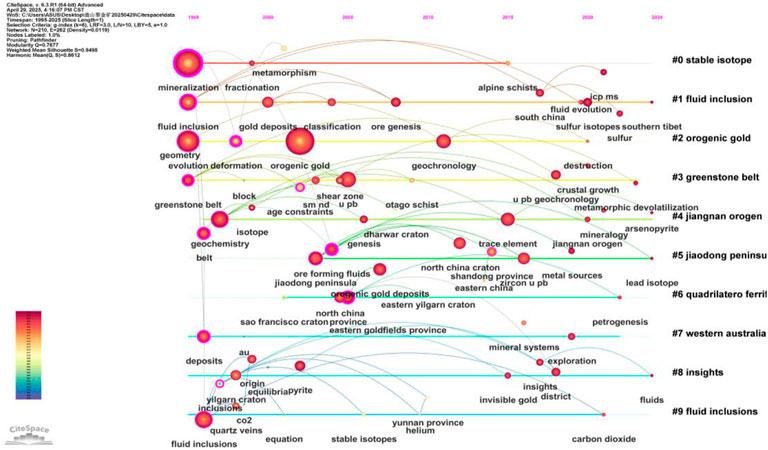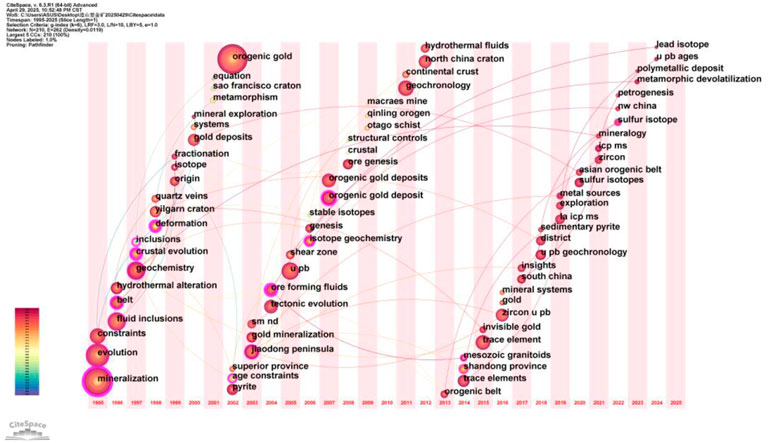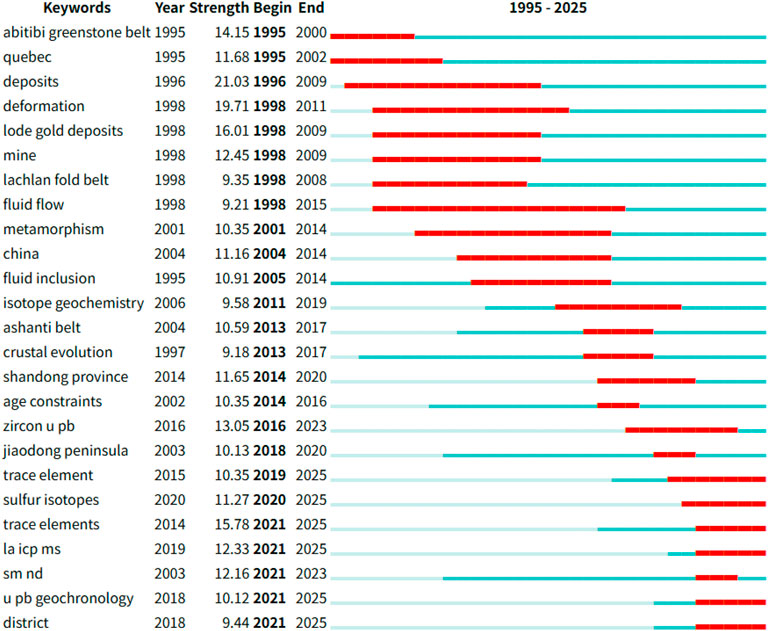- 1College of Earth and Planetary Sciences, Chengdu University of Technology, Chengdu, China
- 2Library, Chengdu University of Technology, Chengdu, China
Orogenic gold deposits represent a vital component of global gold reserves, functioning as both significant sources of gold and essential indicators for understanding crustal metallogeny within collisional tectonic environments. This study employs bibliometric analysis on 2,476 publications sourced from the Web of Science Core Collection (1995–2025) to delineate the intellectual evolution and emerging frontiers in orogenic gold research. Through systematic examination utilizing Citespace and Vosviewer, we identify publication trends, geographic distribution, institutional contributions, and citation networks of global orogenic gold deposit studies. Key findings reveal concentrated research output from China (1,031 papers), Australia (626 papers), and Canada (326 papers), with the China University of Geosciences and the University of Western Australia emerging as prominent institutional hubs. While Deng Jun and Santosh M. lead contemporary productivity metrics, foundational contributions by Groves DI (3,459 citations) and Goldfarb RJ (4,590 citations) continue to serve as pivotal citation anchors. Based on the analysis, the research frontiers should focus on three key areas: (1) Cross-scale mineralization mechanism studies, including numerical simulations of supercritical fluid (H2O-CO2 ± CH4) phase behavior, four-dimensional visualization reconstruction of lithospheric material cycles, and quantitative analysis of pressure-driven (∼150 MPa) phase transitions and adsorption kinetics in sulfide-mantle fluid coupling mechanisms; (2) Technological and methodological advancements, emphasizing the development of AI-powered three-dimensional orebody prediction models and the establishment of deep exploration technology consortia capable of penetrating up to 8 km; (3) Theoretical paradigm shifts, promoting the integration of micro-area isotopic tracing techniques with deep dynamic models to elucidate the control mechanisms of supercontinent cycles on the spatiotemporal architecture of mineralization systems. This field is transitioning from empirical exploration toward a theory-driven research paradigm.
1 Introduction
Orogenic gold deposits represent a substantial proportion of global gold resources and have long been a central focus in geological research. The mechanisms underlying their formation and their spatiotemporal distribution patterns remain key areas of investigation. Since 1995, the intensity of research in this field has progressively increased, leading to the establishment of a distinct disciplinary framework. The classification system proposed by Groves et al. (1998) provided a robust foundation for constructing the theoretical framework governing orogenic gold deposit genesis and subsequent advancements. Following this, the integration of isotope tracing techniques with metallogenic dynamic models became a prominent research focus. The innovative theory regarding the diversity of ore-forming fluids proposed by Goldfarb and Groves (2015) was substantiated through advanced isotopic analyses. Scholars have increasingly emphasized the diversity of fluid sources and their evolutionary behaviors under varying geological conditions.
After 2015, the widespread adoption of microanalytical techniques, particularly laser ablation inductively coupled plasma mass spectrometry (LA-ICP-MS), facilitated a shift from macroscopic structural analysis to nanomineralogical observation. This advancement enhanced the precision of metallogenic chronology from the million-year scale to the ten-thousand-year scale, offering unprecedented insights into the fine-scale material sources and migration mechanisms during gold mineralization (Goldfarb and Groves, 2015; Wang et al., 2019; Deng et al., 2020a; Goldfarb, 2020; Groves et al., 2020; Santosh and Groves, 2023). The crust-mantle mixed lead model (μ = 9.3–9.8) and mantle-derived sulfur isotope characteristics observed in the Jiaodong deposits provide critical geological evidence supporting the mantle fluid hypothesis for orogenic gold deposits (Xiao et al., 2023; Gao et al., 2024; Yang et al., 2024; Zhang et al., 2024; Wang et al., 2024; Wang et al., 2025). Emerging research directions, such as sulfur isotope tracing (δ34S = −5‰ to +12‰) and metal source tracking (Δ199Hg ≈ 0), are gaining increasing attention (Deng et al., 2018; Yang et al., 2021; Liu et al., 2022; Gao et al., 2024; Wang et al., 2024; Wu et al., 2024; Zhang et al., 2024; Chen et al., 2025).
Over the past 3 decades, research on orogenic gold deposits has experienced significant growth, encompassing the development of fundamental theoretical frameworks, the application of multidisciplinary technologies, and breakthroughs in frontier theories. Given the extensive body of literature on orogenic gold deposits, it is imperative to systematically evaluate and synthesize the accumulated knowledge in this field to identify future research priorities. This study aims to employ bibliometric methods to systematically analyze the knowledge evolution of orogenic gold deposit research from 1995 to 2025, elucidate the intrinsic laws governing disciplinary development, and establish a scientific basis for determining future research directions (Albert and Barabasi, 2002; Chen, 2004; Chen, 2006; Chen et al., 2012; Boyd and Crawford, 2012; Chen et al., 2014; Xie, 2015; Hou et al., 2018).
2 Data and methods
2.1 Data sources
The Web of Science Core Collection (WoSCC) database, an internationally acknowledged authoritative academic resource platform, encompasses multiple disciplines such as natural sciences, social sciences, arts, and humanities. On 29 April 2025, a bibliometric analysis was conducted using the search formula “TS = (Orogenic Gold Deposit Or Quartz Vein-Type Gold Deposit Or Shear Zone-Hosted Gold Deposit Or Altered Rock-Hosted Gold Deposit Or Lode Gold Deposit Or Mesothermal Gold Deposit Or Stockwork-Cataclastic Gold Deposit Or Tectonic-Hydrothermal Gold Deposit Or Greenstone Belt-Type Gold Deposit Or Ductile Shear Zone-Hosted Gold Deposit Or Metamorphic Core Complex-Related Gold Deposit Or Strata-Bound Gold Deposit in Orogenic Belts) NOT TS = (Epithermal OR Carlin-Type OR Porphyry OR Skarn OR IOCG OR VMS OR Placer OR Laterite).” This yielded 2,476 papers (articles and reviews) published between 1995 and 2025, with a cumulative citation count of 70,015 (Jahangirian et al., 2011; Chen et al., 2012; Hou et al., 2017; Liao et al., 2018; Wang et al., 2018; Yao et al., 2019).
2.2 Methodology
To analyze the dataset, this study combined CiteSpace and VOSviewer, two leading bibliometric tools. CiteSpace is adept at time-series analysis, detecting emergent trends, and analyzing network dynamics, while VOSviewer excels in constructing visual networks, performing cluster analysis, and generating density views. The integration of these tools enables dual analyses in temporal and spatial dimensions, constructing a multi-dimensional scientific knowledge graph that visually presents the developmental trajectory and frontier hotspots in orogenic gold deposit research (Van Eck and Waltman, 2010; Chen et al., 2014; Kim and Chen, 2015; Kim et al., 2016; Sivarajah et al., 2017; Zuo et al., 2021).
3 Results
3.1 Publication trends
Research activity on orogenic gold deposits can be divided into three distinct phases. From 1995 to 2003, the field was in its nascent stage, with a total of 302 papers and total citation frequency of 14,550 times. The primary focus is on elucidating the mechanisms by which tectonic activities, such as shear zones and strike-slip faults, regulate fluid migration pathways and control the spatial distribution of mineralization. Additionally, attention is given to the evolution of fluid characteristics, including temperature, pressure, and composition, during the mineralization process. The period from 2004 to 2014 witnessed rapid development, published 652 papers with total citation frequency of 31,891 times, and an average of 48.91 citations per paper. During this phase, the study places greater emphasis on the tectonic setting and its control over mineralization, particularly highlighting the role of dynamic tectonic events (such as extension-compression transitions) in driving the formation and opening of ore veins. Additionally, attention is devoted to the sources of ore-forming fluids (metamorphic, magmatic, mantle), fluid evolution under varying P-T-X conditions, mechanisms of metal migration and precipitation, and isotopic tracing techniques. Since 2015, the field has entered a prosperous stage, with 1,522 papers published, and accounting for 61.47% of the total publications, which with a total citation frequency of 23,574. This phase has witnessed an increasing focus on the origin and evolution of ore-forming fluids (isotopic constraints and tracing, fluid characteristics and evolution, metal sources), the timing of mineralization and associated chronology methods, as well as spatial modeling and analysis. Figure 1 presents the annual variations in the quantity of publications regarding orogenic gold deposits from 1995 to 2025.

Figure 1. Publishing trends on orogenic gold deposits, based on data extracted from the WoSCC (publishing on 1998–2025).
3.2 Collaboration networks
3.2.1 Analysis of countries/regions co-occurrence networks
This analysis reveals that over 103 countries have been involved in the research of orogenic gold deposits. The analysis of collaboration networks reveals significant regional and institutional contributions. China leads in publication output with 1,031 papers, followed by Australia (626 papers), Canada (326 papers), and the United States (180 papers). At the same time, France (0.37) and Germany (0.26) exhibit high intermediary centrality, indicating their pivotal roles as collaboration hubs (Figure 2; Table 1).
3.2.2 Analysis of institutional publication volume and collaboration network
It is shown that 219 collaborating institutions involved. Figure 3 presents the collaboration network of research institutions, where nodes represent institutions; the larger the node, the greater the number of papers published by that institution. The thickness of the lines connecting the nodes indicates the intensity of collaboration.
Among research institutions, the China University of Geosciences has published the most papers (495), followed by the Chinese Academy of Sciences (300) and the University of Western Australia (255). The University of Western Australia demonstrates a strong capacity for resource integration, with an intermediary centrality of 0.71 (Figure 3; Table 2).
3.2.3 Analysis of author collaboration network and co-cited authors
Among the 2,476 retrieved documents, a total of 55 authors are depicted in the figure. Figure 4 presents the collaboration network among authors who have published more than 10 articles, received more than 50 citations, and collaborated more than ten times.
Key authors in the field include Deng Jun who has published 56 papers, Santosh M with 55 papers and Wang Qingfei with 36 papers. Santosh M, Groves Di and Deng Jun are among the most cited authors, 4,072 with 3,459 and 3,456 citations respectively, providing foundational theoretical frameworks for the field (Table 3).
3.3 Knowledge mapping
3.3.1 Analysis of co-cited reference research
The visualization of co-cited references illustrates the knowledge structure and flow within a research field. In this network, literature that occupies pivotal positions serves as a bridge in knowledge transfer, connecting disparate research clusters and facilitating the diffusion of knowledge across subfields.
Among recent orogenic gold-related studies, the three most cited papers are as follows: First, “Orogenic gold deposits: A proposed classification in the context of their crustal distribution and relationship to other gold deposit types” by Groves et al. (1998), published in Ore Geology Reviews, with 1,689 citations. Second, “Gold and Trace Element Zonation in Pyrite Using a Laser Imaging Technique: Implications for the Timing of Gold in Orogenic and Carlin-Style Sediment-Hosted Deposits” by Large et al. (2011), published in Economic Geology, with 858 citations. Third, “Orogenic gold: Common or evolving fluid and metal sources through time” by Goldfarb and Groves (2015), also published in Lithos, with 754 citations. Notably, this publication exhibits the highest betweenness centrality in the network, serving as a pivotal work that has shaped the theoretical advancement of orogenic gold deposit research (Figure 5; Table 4).
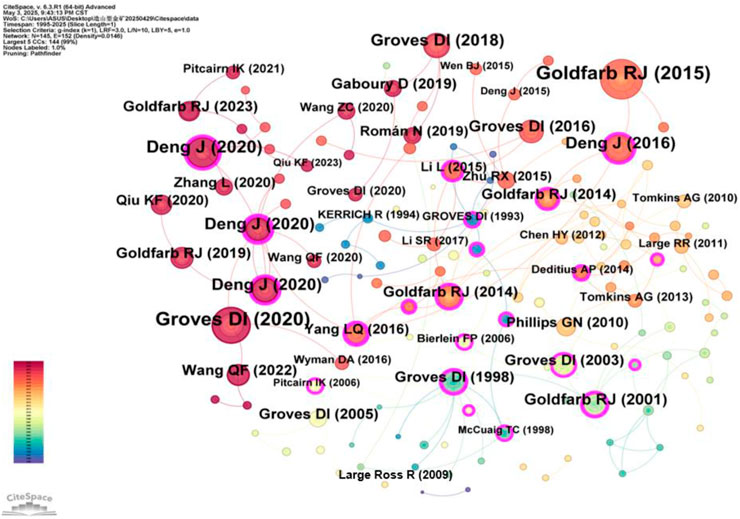
Figure 5. Cited reference article network map with the first author and publication date of each reference article presented.
3.3.2 Keywords analysis
Keywords serve as essential tools for distilling the core themes and critical information of academic literature. They not only succinctly summarize the main ideas but also play a pivotal role in identifying key research directions. The analysis of outbreak scenarios, which identifies sudden increases in keyword frequency, provides valuable insights into current research trends and emerging research priorities. Additionally, knowledge graphs that visualize keyword co-occurrence patterns offer a systematic framework for mapping flourishing research domains and pinpointing pioneering subjects at the forefront of innovation. By systematically summarizing and dissecting keywords, researchers can deeply explore evolving trends, uncover latent research directions, and strategically navigate the dynamic landscape of academic inquiry. This approach not only enhances clarity but also strengthens the analytical foundation for understanding the trajectory of scholarly development.
Co-occurrence analysis of keywords was performed using CiteSpace, yielding 210 relevant keywords (Figure 6). The top 20 high-frequency keywords are presented in Table 5. Among these, the top ten keywords include: “orogenic gold” (554 occurrences), “mineralization” (536 occurrences), “evolution” (452 occurrences), “geochemistry” (280 occurrences), and “constraints” (272 occurrences). This analysis highlights key thematic clusters and research priorities in the field.
Keyword cluster analysis shows the terms form nine major clusters. These involve orogenic belt occurrence locations like the Jiangnan Orogeny, the JiaoDong Peninsula and Western Australia. They also include related greenstone belts, geochemical fluid inclusions, stable isotopes and specific crystal morphologies (Figure 7). These clusters collectively reflect key research areas and thematic groupings within the research dataset.
3.3.3 Timeline and burst analysis
Emerging keyword analysis provides insights into academic frontiers, evolving hotspots, and developmental trends. In this study, key parameters of emerging keywords include occurrence frequency, intensity and temporal distribution. The analysis shows research foci have shifted over time, from early emphasis on ore deposit location, tectonic settings, gold deposits features to investigating evolution of ore-forming fluids, ore-forming metal sources, deposit formation ages and spatial modeling.
CiteSpace keywords timeline spectrum analysis reveals a clear shift in research focus over time. Early studies primarily concentrated on deposit classification and metallogenic models of orgenic gold deposits. In recent years, however, research emphasis has shifted toward fluid properties and the diversity of metallogenic sources. Current investigations prioritize fluid types, fluid sources, and their analytical methodologies in orogenic gold systems, findings consistent with our burst citation analysis results. This shift is driven by advancements in fluid property analysis techniques, which have not only enhanced understanding of orogenic gold deposits but also become increasingly critical for polymetallic gold deposit research (Figure 8). These technological advancements explain the sustained focus on sulfur isotopes, which remain a prominent research topic in recent years.
From 1995 to 2025, research on orogenic gold deposits evolved four stages as follows: from 1995 to 2000, research centered on basic geological concepts. Keywords like “mineralization” and “hydrothermal alteration” show early efforts to understand gold mineralization processes and hydrothermal activity roles. From 2001 to 2010, keywords related to geochemical and isotopic analyses became more common. Terms such as “sulfur isotopes” and “u-pb geochronology” indicate advanced techniques were used to identify gold-bearing fluid sources and mineralization timing. From 2011 to 2020, the focus turned to fluid inclusions and tectonic controls. Keywords like “ore forming fluids” and “geochronology” suggest research explored fluid characteristics in gold deposition and tectonic settings for orogenic gold mineralization. Moreover, from 2021 to 2025: research has focused on exploration and application. Keywords such as “prospecting” and “exploration” show a drive to develop better methods for finding new orogenic gold deposits (Figure 9).
In the context of orogenic gold deposit research, the “strength” metric reflects the emergence value of specific terms, with higher values indicating greater credibility of term emergence within defined periods. Analysis of citation burst keywords in orogenic gold deposit research from 1995 to 2025 reveals four distinct stages: from 1995 to 2000, research focused on classic regions and fundamental geological features. Keywords such as “abiti greenstone belt” and “quebec” highlight the emphasis on specific areas during this period. From 2001 to 2010, a strong focus on fluid characteristics and geological effects. The keyword “fluid flow” indicates active exploration of fluid movement and roles in gold-bearing systems. From 2011 to 2020, research shifted to mineral evolution and age determination. Keywords like “ashanti belt” and “crustal evolution” show extensive study of mineralization processes and chronological sequences in different orogenic belts. From 2021 to 2025, the research direction has moved towards advanced analytical techniques and exploration methods. Keywords such as “la-icp-ms” and “sm-nd” reflect the use of sophisticated analytical techniques for precise determinations (Figure 10).
3.4 Advances in orogenic gold deposits
The formation of orogenic gold deposits is controlled by three primary crustal dynamic systems: (1) the tectonic deformation system induced by thrust metamorphism (Hou et al., 2017; Li and Santosh, 2017; Deng et al., 2020b), (2) the generation and migration system of metamorphic fluids, and (3) the activation-precipitation mechanism of mineralizing elements (Yang et al., 2021; Goldfarb and Iain, 2023). The multi-stage interaction among these systems shapes the systematic mineralization patterns observed in global orogenic belts. This deposit type predominantly forms within accretion-collision orogenic systems, with mineralization ages exhibiting spatio-temporal coupling to supercontinent assembly cycles (Lawrence et al., 2013; Yang et al., 2014; Wyman et al., 2016; Groves et al., 2018; Qiu et al., 2020; Goldfarb, 2020; Wang et al., 2024).
The three-dimensional structural trap system governs orebody positioning, where the structural axis and strain gradient zones serve as conduits for mineralizing fluids. Early-formed structural spaces provide hosting environments, forming a three-dimensional fluid network. Recent studies reveal vertical zonation patterns through fluid inclusion analysis: at depths exceeding 8 km, supercritical H2O-CO2 ± CH4 fluids dominate, transitioning upward to NaCl-H2O systems. Globally, these deposits exhibit consistent geochemical characteristics, including temperatures of 220°C–450°C, salinities of 3%–7% NaCl equivalent, and abundant CO2 components. Isotopic evidence (Δ199Hg ≈ 0, δ56Fe = 0 to +1‰) suggests that 30%–50% of the ore-forming materials originate from the mantle (Groves et al., 2018; Cao et al., 2023; Chen et al., 2025).
Despite advances, debates persist regarding the genesis of orogenic gold deposits. Two primary theoretical frameworks exist: (1) the metamorphic fluid model, which emphasizes gold release via pyrite-pyrrhotite phase transitions; and (2) the mantle fluid model, which attributes ore-forming materials to subducted plates or lithospheric mantle, transported by supercritical fluids. Notably, research on China’s Jiaodong mineralization belt supports the mantle fluid model, with Pb-Hg-S isotopes (δ34S = +8‰ to +12‰) indicating lithospheric mantle sources and subduction-related degassing processes (Tomkins, 2013; Zhang et al., 2014; Deng et al., 2015a; Yang et al., 2016; Carranza, 2017; Román et al., 2019; Li et al., 2020; Wang et al., 2024; Zhang et al., 2024; David et al., 2024; Zhao et al., 2025).
In regional studies, China exhibits a “three-period mineralization and seven-belt distribution” pattern, divided into Paleozoic, Mesozoic, and Cenozoic mineralization domains. The Cretaceous mineralization peak correlates with bidirectional subduction of the Paleo-Pacific and Neo-Tethys plates, with Phanerozoic mineralization belts strictly controlled by orogenic sequences. Mineralization ages typically lag behind regional metamorphic peaks. Additionally, high-permeability basement activation zones have emerged as critical targets for deep exploration (Hronsky et al., 2012; Deng et al., 2014a; Deng and Wang, 2016; Deng et al., 2017; Zhang et al., 2020).
Analysis of existing research highlights significant advancements in exploration techniques for orogenic gold deposits. Micro-area in-situ analyses reveal synchronous evolution trends in pyrite As content (500–2,000 ppm) and Co/Ni ratios. LA-ICP-MS data support the coupled mineralization mechanism involving Au(HS)2- migration and iron sulfide adsorption. Numerical simulations demonstrate that a 150 MPa pressure drop in extensional settings induces fluid boiling, enhancing gold adsorption efficiency through iron sulfide nanocolloids (specific surface area >50 m2/g, Zeta potential <−30 mV) (Deditius et al., 2014; Keith et al., 2018; Zhang et al., 2020; Li et al., 2022; Cao et al., 2023; Jiang et al., 2023).
This type of deposit predominantly occurs in subduction-related accretion-collision orogenic systems, and its mineralization age shows a pronounced spatio-temporal coupling with the supercontinent aggregation cycle (Groves et al., 2018). The localization of the deposit is governed by a three-dimensional structural trap system: ore-conducting channels formed by the structural hinge zone and the strain gradient zone, superimposed on ore-storage space created by early structures, collectively constitute a three-dimensional network for fluid migration. Fluid inclusion studies reveal that the ore-forming fluids exhibit distinct vertical zonation characteristics. At depths greater than 8 km, H2O-CO2 ± CH4 supercritical fluids dominate, transitioning upward to the NaCl-H2O system at shallower levels. Isotopic geochemical evidence (Δ199Hg ≈ 0, δ56Fe = 0 to +1‰) further confirms that approximately 30%–50% of mantle-derived materials were incorporated into the gold mineralization process (Chen et al., 2007; Cao et al., 2023; Yang et al., 2023; Liu et al., 2025).
Although the host rocks of orogenic gold deposits worldwide vary widely (from greenschist facies to amphibolite facies metamorphic rocks) and their mineralization ages span from the Neoarchean to the Cenozoic, these deposits commonly exhibit consistent fluid geochemical characteristics: low to moderate temperatures (220°C–450°C), low salinities (3%–7% NaCl eq.), and CO2-rich compositions (Groves et al., 2018). This observation has facilitated the advancement of the mantle-crust synergetic mineralization theory. The conventional mineralization model, which solely relies on the exsolution of metamorphic fluids, is now insufficient to explain the formation mechanisms of high-temperature plutonic ore deposits. Current studies increasingly emphasize that lithospheric-scale crust-mantle interaction plays a critical role in mineralization, with deep transformation events triggered by the supercontinent cycle providing the fundamental dynamic context. Due to its high-permeability structural features, the Precambrian amphibolite facies domain is emerging as a promising target for deep resource exploration (Deng et al., 2018; Wang et al., 2020; Zhang et al., 2022).
There are two predominant schools of thought in the study of genetic models: The metamorphic fluid model highlights the gold-releasing mechanism via the phase transition of pyrite to pyrrhotite, whereas the mantle-derived fluid model argues that ore-forming materials originate from subducting slabs or the lithospheric mantle, with supercritical fluids driving metal migration under non-equilibrium conditions (Nykänen et al., 2015; Liu et al., 2021; Zhao et al., 2022; David et al., 2024). Research on the Jiaodong ore concentration area in China provides critical evidence for this. Its Pb-Hg-S isotopic system reveals that ore-forming materials derive from the enriched lithospheric mantle, and the heavy δ34S values (+8‰ to +12‰) confirm the dominant role of devolatilization processes in subducting slabs. The “detachment fault system + basement activation zone + mantle source channel” composite ore-controlling model established based on this region demonstrates that asthenosphere upwelling triggered by the rollback of the Paleo-Pacific plate forms fluid conduits through the Tan-Lu Fault Zone, resulting in a negative correlation between the intensity of gold mineralization and the distance from the fault. This offers new insights into the dynamics of intracontinental mineralization (Goldfarb et al., 2014; Li et al., 2015; Li and Santosh, 2017; Wang et al., 2019; Zhang et al., 2024).
Orogenic gold deposits in China exhibit a distinctive pattern characterized by “three mineralization periods and seven distribution belts” and are categorized into three primary mineralization domains: the Paleozoic, Mesozoic, and Cenozoic (Deng et al., 2015b). The mineralization peak during the Cretaceous is dynamically linked to the bidirectional subduction of the Paleo-Pacific Plate and the Neo-Tethys Plate. The spatio-temporal distribution of the seven Phanerozoic metallogenic belts is strictly governed by the sequence of orogenic events, with mineralization ages generally lagging behind the peak of regional metamorphism. Investigations into the mineralization characteristics of specific geological units, such as the Cathaysia Block and the Qingshan Deposit, have further substantiated the universality of the mantle-derived fluid mineralization model (Deng et al., 2014b; Groves and Santosh, 2016; Wang et al., 2019; Groves et al., 2020; Jiang and Ma, 2024).
Innovations in technical methodologies have substantially advanced the understanding of ore genesis mechanisms. Micro-area in situ isotope analysis demonstrates that the As content in pyrite displays a core-edge gradient variation (500 ppm → 2000 ppm), which aligns with the evolutionary trends of the Co/Ni ratio. Combined with fluid inclusion composition data obtained via LA-ICP-MS, this has led to the establishment of a coupled mineralization mechanism involving Au(HS)2- complex migration and adsorption by iron sulfide colloids. Numerical simulations further confirm that a pressure drop of approximately 150 MPa in an extensional tectonic setting can induce fluid boiling, while iron sulfide nanocolloids (specific surface area >50 m2/g) markedly enhance gold adsorption efficiency through surface charge regulation (Zeta potential <−30 mV) (Fougerouse et al., 2016; Deng et al., 2020b; Li et al., 2022; Cao et al., 2023; Wu et al., 2024).
4 Discussion
This study utilized bibliometric methods to systematically elucidate the trajectory of knowledge evolution in orogenic gold deposits from 1995 to 2025. The findings indicate that the development of this discipline follows a three-stage evolutionary pattern characterized by “theoretical foundation - technological integration - paradigm breakthrough,” which aligns closely with the continuous upgrading of global mineral resource strategic demands and the revolutionary advancements in analytical techniques.
From a geographical distribution perspective, the global research landscape exhibits a distinct “dual-core drive” feature. China has established its academic authority through 1,031 publications, leveraging its resource endowment in the Tethyan-Pacific composite metallogenic domain and substantial national-level research investment. Meanwhile, France and Germany have demonstrated their capabilities as traditional European geological powers by playing key roles in transnational cooperation networks, showcasing their expertise in knowledge integration.
The evolution trajectory of keywords clearly delineates three major paradigm shifts in research: (1) A shift in research perspective from static deposit description to dynamic process deconstruction (from “mineralization” to “fluid evolution”); (2) An evolution in analytical paradigms from qualitative descriptions to quantitative modeling (methodology transitioning from “geochemistry” to “spatial modeling”); and (3) A practical orientation shift from empirical exploration to theory-driven approaches (paradigm transitioning from “tectonic environment” to “prospecting prediction”).
Through keyword clustering and co-occurrence mapping, two mainstream theories at the current disciplinary frontier were identified: (1) The metamorphic fluid school emphasizes ore-controlling mechanisms via sulfide phase transformations (δ34S = −5‰ to +5‰), while (2) the mantle fluid school advocates for the contribution of deep materials (Δ199Hg ≈ 0). Recent numerical simulations suggest that the fluid phase transition process triggered by a pressure drop of 150 MPa (Zeta potential <−30 mV) may represent a critical breakthrough in unifying these two theories.
Based on existing research results, it is recommended that future studies focus on three core directions: (1) Simulating the phase evolution of supercritical fluids (H2O-CO2 ± CH4) and their cross-sphere migration mechanisms; (2) Reconstructing the lithospheric material cycle in four-dimensional spatiotemporal dynamics; and (3) Developing high-precision orebody location predictions driven by artificial intelligence. To achieve these goals, the research path should emphasize: (1) Constructing quantitative models of crust-mantle material contributions and clarifying the multi-sphere interaction processes of supercritical fluids; (2) Developing next-generation deep exploration technology systems to overcome existing exploration bottlenecks. For example, the “four-step” exploration model established in the Jiaodong metallogenic belt achieved significant mineral exploration breakthroughs at depths exceeding 2,000 m. Its theoretical framework—“structural analysis - fluid tracing - mineralization simulation - engineering verification”—provides a paradigm for continental gold exploration. Additionally, integrating multi-isotope coupled tracing technology with three-dimensional dynamic prediction models can promote a fundamental transformation in deep mineral exploration, transitioning from an empirical statistical model to a process-driven model (Thébaud and Rey, 2013; Goldfarb and Santosh, 2014; Sun et al., 2019; Zhao et al., 2022; Zhang et al., 2022; Jiang et al., 2023).
5 Conclusion
This study reveals a clear trajectory of theoretical foundation - technological integration - paradigm breakthrough in the research on orogenic gold deposits: ① during the theoretical foundation period (1995–2003), the focus was on tectonic ore-controlling mechanisms, establishing a classification system represented by Groves et al. (1998) in “Reviews in Mineralogy and Geochemistry.” ② In the subsequent technological integration period (2004–2014), cross-innovation was achieved through the combination of isotope tracing and mineralization dynamic modeling, validating Goldfarb and Groves (2015) theoretical breakthrough regarding fluid multiplicity. ③ The ongoing paradigm breakthrough period (2015–2025), marked by the widespread application of LA-ICP-MS micro-area analysis technology (with a technology intensity index of 9.87), accomplished a leap in research scale from macroscopic tectonics to nanomineralogy, overcoming the million-year-level precision bottleneck in mineralization chronology.
The global scientific landscape exhibits a “four-pole multi-point” competitive pattern: China (1,031 papers), Australia (626 papers), Canada (326 papers), and the United States (180 papers) constitute the core contributors. France (betweenness centrality of 0.37) and Germany (0.26) play pivotal roles in transnational cooperation networks, while the University of Western Australia (betweenness centrality of 0.71) forms a unique academic bridge based on the Yilgarn Craton. Major institutions include the China University of Geosciences (495 papers), the Chinese Academy of Sciences (300 papers), and the University of Western Australia (255 papers). High-productivity authors such as Deng Jun (56 papers), Santosh M (55 papers), and Wang Qingfei (36 papers), along with highly cited scholars Groves DI (3,459 citations) and Goldfarb RJ (4,590 citations), lead the field’s development.
Keyword co-occurrence analysis identifies nine research clusters, with core terms such as “orogenic gold deposits” (554 occurrences), “mineralization” (536 occurrences), and “evolution” (452 occurrences) forming the theoretical basis.
The timeline spectrum reveals that the research focus has transitioned from an early emphasis on tectonic activities, fluid migration, and mineralization mechanisms (1995–2014) to the investigation of the origin and evolution of ore-forming fluids, as well as the spatiotemporal modeling of mineralization processes (2015–2025). Emerging research directions, including isotopic constraints and tracing of ore-forming fluids, and the study of metal sources, have progressively gained significance. In the co-citation network, Groves et al.’s (1998) classification system paper (cited 1,689 times) and Goldfarb RJ et al.'s (2015) fluid evolution theory (cited 754 times) serve as key knowledge bridges.
Two major theoretical debates exist at the disciplinary frontier: The metamorphic fluid school emphasizes ore control via sulfide phase transformation (δ34S = −5‰∼+5‰), while the mantle fluid school advocates for deep material contributions (Δ199Hg ≈ 0). The mantle-source sulfur isotope characteristics (+8‰∼+12‰) and the crust-mantle mixed lead model (μ = 9.3–9.8) of the Jiaodong deposits provide critical evidence for the latter. The technological revolution has advanced understanding of mineralization mechanisms. LA-ICP-MS (intensity 9.87) and Sm-Nd dating (8.42) technologies have enabled mineralization chronology precision at the 100,000-year level, supporting Wang et al.’s (2019) “three-stage mineralization” theory. Numerical simulations suggest that fluid boiling triggered by a 150 MPa pressure drop and sulfide colloid adsorption (Zeta potential <−30 mV) may serve as a key point for integrating theories.
The discipline faces three major challenges: ①The English literature bias in the WoSCC database may underestimate contributions from non-English-speaking countries; ②Data for 2024–2025 contain predictive components requiring subsequent validation; ③There remains a theoretical gap in simulating the phase behavior of supercritical fluids (H2O-CO2 ± CH4). Future research should focus on:①Constructing a 4D visualization platform for lithospheric material cycles; ②Developing AI-driven orebody location prediction systems; ③Establishing international deep-drilling alliances (drilling depth >8 km) to promote the cross-integration of deep exploration technology and big data analysis. This study’s multi-dimensional analytical framework not only provides a methodological reference for geological bibliometrics but also offers valuable insights into the inherent logic of knowledge evolution.
Data availability statement
The raw data supporting the conclusions of this article will be made available by the authors, without undue reservation.
Author contributions
KXL: Writing – original draft, Writing – review and editing. NJ: Writing – original draft, Writing – review and editing. YQZ: Writing – original draft, Writing – review and editing.
Funding
The author(s) declare that financial support was received for the research and/or publication of this article. This research was supported by Discipline Development Evaluation Research Center foundation (2024XKFZPJ-Z02) and Chengdu University of Technology (2025 Philosophical and Social Science Research Fund).
Acknowledgments
Sincere gratitude to the editorial team of Frontiers in Earth Science, as well as to the reviewers for their invaluable contributions.
Conflict of interest
The authors declare that the research was conducted in the absence of any commercial or financial relationships that could be construed as a potential conflict of interest.
Generative AI statement
The author(s) declare that no Generative AI was used in the creation of this manuscript.
Publisher’s note
All claims expressed in this article are solely those of the authors and do not necessarily represent those of their affiliated organizations, or those of the publisher, the editors and the reviewers. Any product that may be evaluated in this article, or claim that may be made by its manufacturer, is not guaranteed or endorsed by the publisher.
References
Albert, R., and Barabási, A.-L. (2002). Statistical mechanics of complex networks. Rev. Mod. Phys. 74, 47–97. doi:10.1103/RevModPhys.74.47
Boyd, D., and Crawford, K. (2012). CRITICAL QUESTIONS FOR BIG DATA: provocations for a cultural, technological, and scholarly phenomenon. Inf. Commun. Soc. 15, 662–679. doi:10.1080/1369118X.2012.678878
Cao, G. S., Zhang, Y., and Chen, H. Y. (2023). Trace elements in pyrite from orogenic gold deposits: implications for metallogenic mechanism. Acta Petrol. Sin. 39 (8), 2330–2346. doi:10.18654/1000-0569/2023.08.06
Carranza, E. J. M. (2017). Natural resources research publications on geochemical anomaly and mineral potential mapping, and introduction to the special issue of papers in these fields. Nat. Resour. Res. 26 (4), 379–410. doi:10.1007/s11053-017-9348-1
Chen, C. (2004). Searching for intellectual turning points: progressive knowledge domain visualization. Proc. Natl. Acad. Sci. U. S. A. 101 (Suppl. S1), 5303–5310. doi:10.1073/pnas.0307513100
Chen, C. M. (2006). CiteSpace II: detecting and visualizing emerging trends and transient patterns in scientific literature. J. Am. Soc. Inf. Sci. Technol. 57 (3), 359–377. doi:10.1002/asi.20317
Chen, C. M., Dubin, R., and Kim, M. C. (2014). Emerging trends and new developments in regenerative medicine: a scientometric update (2000 - 2014). Expert Opin. Biol. Ther. 14 (9), 1295–1317. doi:10.1517/14712598.2014.920813
Chen, C. M., Hu, Z. G., Liu, S. B., and Tseng, H. (2012). Emerging trends in regenerative medicine: a scientometric analysis in CiteSpace. Expert Opin. Biol. Ther. 12 (5), 593–608. doi:10.1517/14712598.2012.674507
Chen, H. Y., Chen, Y. J., Ni, P., and Zhang, Z. L. (2007). Chemical composition of fluid inclusions of the Sawayardun gold deposit, Xinjiang: implications for oregenesis and prediction. Acta Petrol. Sin. 23 (9), 2189–2197.
Chen, Y. L., Li, H., Gu, S. Y., Whattam, S. A., Zheng, C. y., Wang, L. g., et al. (2025). Geochemistry, geochronology and Fe-Mg-S isotopic composition of the Liaoshang gold deposit, Jiaodong Peninsula, China: implications for ore-forming processes and mineral exploration. J. Geochem. Explor. 273, 107738. doi:10.1016/j.gexplo.2025.107738
David, I. G., Santosh, M., Qingfei, W., Liang, Z., and Hesen, Z. (2024). The Boring Billion: a key to resolving controversy on ore-fluid source models for orogenic gold deposits? Miner. Deposita 59, 435–444. doi:10.1007/s00126-023-01244-1
Deditius, A. P., Reich, M., Kesler, S. E., Utsunomiya, S., Chryssoulis, S. L., Walshe, J., et al. (2014). The coupled geochemistry of Au and as in pyrite from hydrothermal ore deposits. Geochimica Cosmochimica Acta 140, 644–670. doi:10.1016/j.gca.2014.05.045
Deng, J., Liu, X. F., Wang, Q. F., and Pan, R. G. (2015a). Origin of the Jiaodong-type Xinli gold deposit, Jiaodong Peninsula, China: constraints from fluid inclusion and C-D-O-S-Sr isotope compositions. Ore Geol. Rev. 65, 674–686. doi:10.1016/j.oregeorev.2014.04.018
Deng, J., Qiu, K. F., Wang, Q. F., Goldfarb, R., Yang, L. Q., Zi, J. W., et al. (2020a). In situ dating of hydrothermal monazite and implications for the geodynamic controls on ore formation in the JiaoDong gold province, eastern China. Econ. Geol. 115 (3), 671–685. doi:10.5382/econgeo.4711
Deng, J., Wang, C. M., Bagas, L., Carranza, E. J. M., and Lu, Y. J. (2015b). Cretaceous-Cenozoic tectonic history of the Jiaojia Fault and gold mineralization in the Jiaodong Peninsula, China: constraints from zircon U-Pb, illite K-Ar, and apatite fission track thermochronometry. Miner. Deposita 50 (8), 987–1006. doi:10.1007/s00126-015-0584-1
Deng, J., Wang, C. M., Bagas, L., Santosh, M., and Yao, E. Y. (2018). Crustal architecture and metallogenesis in the south-eastern North China Craton. Earth-Science Rev. 182, 251–272. doi:10.1016/j.earscirev.2018.05.001
Deng, J., and Wang, Q. F. (2016). Gold mineralization in China: metallogenic provinces, deposit types and tectonic framework. Gondwana Res. 36, 219–274. doi:10.1016/j.gr.2015.10.003
Deng, J., Wang, Q. F., and Li, G. J. (2017). Tectonic evolution, superimposed orogeny, and composite metallogenic system in China. Gondwana Res. 50, 216–266. doi:10.1016/j.gr.2017.02.005
Deng, J., Wang, Q. F., Li, G. J., Li, C. S., and Wang, C. M. (2014a). Tethys tectonic evolution and its bearing on the distribution of important mineral deposits in the Sanjiang region, SW China. Gondwana Res. 26 (2), 419–437. doi:10.1016/j.gr.2013.08.002
Deng, J., Wang, Q. F., Li, G. J., and Santosh, M. (2014b). Cenozoic tectono-magmatic and metallogenic processes in the Sanjiang region, southwestern China. Earth-Science Rev. 138, 268–299. doi:10.1016/j.earscirev.2014.05.015
Deng, J., Wang, Q. F., Yang, L., Liu, X., Liang, Y., et al. (2020b). Remobilization of metasomatized mantle Lithosphere: a new model for the Jiaodong gold province, eastern China. Miner. Deposita 55 (2), 257–274. doi:10.1007/s00126-019-00925-0
Deng, J., Yang, L. Q., Groves, D. I., Zhang, L., Qiu, K. F., and Wang, Q. F. (2020). An integrated mineral system model for the gold deposits of the giant Jiaodong province, eastern China. Earth-Science Rev. 208, 103274. doi:10.1016/j.earscirev.2020.103274
Fougerouse, D., Micklethwaite, S., Tomkins, A. G., Mei, Y., Kilburn, M., Guagliardo, P., et al. (2016). Gold remobilisation and formation of high grade ore shoots driven by dissolution-reprecipitation replacement and Ni substitution into auriferous arsenopyrite. Geochimica Cosmochimica Acta 178, 143–159. doi:10.1016/j.gca.2016.01.040
Gao, W., Hu, R. Z., Wang, X. Y., Yin, R., Bi, X., Xie, Z., et al. (2024). Large-scale basement mobilization endows the giant Carlin-type gold mineralization in the Youjiang Basin, South China Insights from mercury isotopes. Geol. Soc. Am. Bull. 135 (11-12), 3163–3172. doi:10.1130/B36636.1
Goldfarb, R. J. (2020). An overview of mineral deposits of China. Seg. Discov. 123, 11–20. doi:10.5382/SEGnews.2020-123.fea
Goldfarb, R. J., and Groves, D. I. (2015). Orogenic gold: common or evolving fluid and metal sources through time. Lithos 233, 2–26. doi:10.1016/j.Lithos.2015.07.011
Goldfarb, R. J., and Iain, P. (2023). Orogenic gold: is a genetic association with magmatism realistic? Miner. Deposita 58 (58), 5–35. doi:10.1007/s00126-022-01146-8
Goldfarb, R. J., and Santosh, M. (2014). The dilemma of the Jiaodong gold deposits: are they unique? Geosci. Front. 5 (2), 139–153. doi:10.1016/j.gsf.2013.11.001
Goldfarb, R. J., Taylor, R. D., Collins, G. S., Goryachev, N. A., and Orlandini, O. F. (2014). Phanerozoic continental growth and gold metallogeny of Asia. Gondwana Res. 25 (1), 48–102. doi:10.1016/j.gr.2013.03.002
Groves, D. I., Goldfarb, R. J., Gebre-Mariam, M., Hagemann, S., and Robert, F. (1998). Orogenic gold deposits: a proposed classification in the context of their crustal distribution and relationship to other gold deposit types. Ore Geol. Rev. 13 (1-5), 7–27. doi:10.1016/S0169-1368(97)00012-7
Groves, D. I., and Santosh, M. (2016). The giant Jiaodong gold province: the key to a unified model for orogenic gold deposits? Geosci. Front. 7 (3), 409–417. doi:10.1016/j.gsf.2015.08.002
Groves, D. I., Santosh, M., Deng, J., Wang, Q. F., Yang, L. Q., and Zhang, L. (2020). A holistic model for the origin of orogenic gold deposits and its implications for exploration. Miner. Deposita 55 (2), 275–292. doi:10.1007/s00126-019-00877-5
Groves, D. I., Santosh, M., Goldfarb, R. J., and Zhang, L. (2018). Structural geometry of orogenic gold deposits: implications for exploration of world-class and giant deposits. Geosci. Front. 9 (4), 1163–1177. doi:10.1016/j.gsf.2018.01.006
Hou, J., Yang, X., and Chen, C. (2018). Emerging trends and new developments in information science: a document co-citation analysis (2009-2016). Scientometrics 115, 869–892. doi:10.1007/s11192-018-2695-9
Hou, Z. Q., Zhou, Y., Wang, R., Zheng, Y. C., He, W. Y., Zhao, M., et al. (2017). Recycling of metal-fertilized lower continental crust: origin of non-arc Au-rich porphyry deposits at cratonic edges. Geology 45 (6), 563–566. doi:10.1130/G38619.1
Hronsky, J. M. A., Groves, D. I., Loucks, R. R., and Begg, G. C. (2012). A unified model for gold mineralisation in accretionary orogens and implications for regional-scale exploration targeting methods. Miner. Deposita 47 (4), 339–358. doi:10.1007/s00126-012-0402-y
Jahangirian, M., Eldabi, T., Garg, L., Jun, G. T., Naseer, A., Patel, B., et al. (2011). A rapid review method for extremely large corpora of literature: applications to the domains of modelling, simulation, and management. Int. J. Inf. Manag. 31, 234–243. doi:10.1016/j.ijinfomgt.2010.07.004
Jiang, S. Y., and Ma, Y. (2024). Spatiotemporal distribution, geological and geochemical characteristics, metallogenic mechanism and tectonic setting of orogenic gold deposits in the Cathaysia Block. Acta Geol. Sin. 98 (3), 920–940. doi:10.19762/j.cnki.dizhixuebao.2023375
Jiang, S. Y., Ma, Y., Liu, D. L., and Li, W. T. (2023). Orogenic gold deposits: mineralization mechanism and research perspectives. J. Earth Sci. 34 (6), 1758–1761. doi:10.1007/s12583-023-2005-1
Keith, M., Smith, D. J., Jenkin, G. R. T., Holwell, D. A., and Dye, M. D. (2018). A review of Te and Se systematics in hydrothermal pyrite from precious metal deposits: insights into ore-forming processes. Ore Geol. Rev. 96, 269–282. doi:10.1016/j.oregeorev.2017.07.023
Kim, M. C., and Chen, C. M. (2015). A scientometric review of emerging trends and new developments in recommendation systems. Scientometrics 104 (1), 239–263. doi:10.1007/s11192-015-1595-5
Kim, M. C., Zhu, Y. J., and Chen, C. M. (2016). How are they different? A quantitative domain comparison of information visualization and data visualization (2000-2014). Scientometrics 107 (1), 123–165. doi:10.1007/s11192-015-1830-0
Large, R. R., Bull, S. W., and Maslennikov, V. V. (2011). A carbonaceous sedimentary source-rock model for carlin-type and orogenic gold deposits. Econ. Geol. 106 (3), 331–358. doi:10.2113/econgeo.106.3.331
Large, R. R., Danyushevsky, L., Hollit, C., Maslennikov, V., Meffre, S., Gilbert, S., et al. (2009). Gold and trace element zonation in pyrite using a laser imaging technique: implications for the timing of gold in orogenic and carlin-style sediment-hosted deposits. Econ. Geol. 104 (5), 635–668. doi:10.2113/gsecongeo.104.5.635
Lawrence, D. M., Treloar, P. J., Rankin, A. H., Harbidge, P., and Holliday, J. (2013). The Geology and Mineralogy of the loulo mining district, Mali, West Africa: evidence for two distinct styles of orogenic gold mineralization. 108 (2), 199–227. doi:10.2113/econgeo.108.2.199
Li, H. J., Wang, Q. F., Deng, J., Yu, H. Z., Sun, P. F., Dong, C. Y., et al. (2020). Source and evolution of ore fluids in the Zhenyuan orogenic gold deposit, SE Tibet: constraints from the S-C-O isotopes. Ore Geol. Rev. 121, 103534. doi:10.1016/j.oregeorev.2020.103534
Li, H. J., Wang, Q. F., Yang, L., Dong, C., Weng, W., and Deng, J. (2022). Alteration and mineralization patterns in orogenic gold deposits: constraints from deposit observation and thermodynamic modeling. Chem. Geol. 607, 121012. doi:10.1016/j.chemgeo.2022.121012
Li, L., Santosh, M., and Li, S. R. (2015). The 'Jiaodong type' gold deposits: characteristics, origin and prospecting. Ore Geol. Rev. 65, 589–611. doi:10.1016/j.oregeorev.2014.06.021
Li, S. R., and Santosh, M. (2017). Geodynamics of heterogeneous gold mineralization in the North China Craton and its relationship to Lithospheric destruction. Gondwana Res. 50, 267–292. doi:10.1016/j.gr.2017.05.007
Liao, H., Tang, M., Luo, L., Li, C., Chiclana, F., and Zeng, X.-J. (2018). A bibliometric analysis and visualization of medical big data research. Sustainability 10, 166. doi:10.3390/su10010166
Liu, X. M., Zhu, F. L., Liu, S. T., Tan, Q. P., Wang, L., Yue, Y. F., et al. (2022). Tracing concealed gold deposits using mercury isotopes in surface soils: a study from the Shuiyindong gold deposit, Guizhou province, China. J. Geochem. Explor. 238, 107015. doi:10.1016/j.gexplo.2022.107015
Liu, Y. H., Mao, J. W., Hu, J., Ma, J. D., Wang, L., Xu, D. M., et al. (2025). Element migration and hydrothermal alteration of the Tuwaishan orogenic gold deposit in West Hainan Island, South China. Ore Geol. Rev. 180, 106568. doi:10.1016/j.oregeorev.2025.106568
Liu, Z. K., Hollings, P., Mao, X. C., Lawley, C. J. M., Yang, B., and Tang, L. (2021). Metal remobilization from country rocks into the Jiaodong-type orogenic gold systems, Eastern China: new constraints from scheelite and galena isotope results at the Xiadian and Majiayao gold deposits. Ore Geol. Rev. 134, 104126. doi:10.1016/j.oregeorev.2021.104126
Nykänen, V., Lahti, I., Niiranen, T., and Korhonen, K. (2015). Receiver operating characteristics (ROC) as validation tool for prospectivity models - a magmatic Ni-Cu case study from the Central Lapland Greenstone Belt, Northern Finland. Ore Geol. Rev. 71, 853–860. doi:10.1016/j.oregeorev.2014.09.007
Qiu, K. F., Yu, H. C., Deng, J., McIntire, D., Gou, Z. Y., Geng, J. Z., et al. (2020). The giant Zaozigou Au-Sb deposit in West Qinling, China: magmatic- or metamorphic-hydrothermal origin? Miner. Deposita 55 (2), 345–362. doi:10.1007/s00126-019-00937-w
Román, N., Reich, M., Leisen, M., Morata, D., Barra, F., and Deditius, A. P. (2019). Geochemical and micro-textural fingerprints of boiling in pyrite. Geochimica Cosmochimica Acta 246, 60–85. doi:10.1016/j.gca.2018.11.034
Santosh, M., and Groves, D. I. (2023). The Not-So-Boring Billion: a metallogenic conundrum during the evolution from Columbia to Rodinia supercontinents. Earth-Science Rev. 236, 104287. doi:10.1016/j.earscirev.2022.104287
Sivarajah, U., Kamal, M. M., Irani, Z., and Weerakkody, V. (2017). Critical analysis of Big Data challenges and analytical methods. J. Bus. Res. 70, 263–286. doi:10.1016/j.jbusres.2016.08.001
Sun, T., Chen, F., Zhong, L. X., Liu, W. M., and Wang, Y. (2019). GIS-based mineral prospectivity mapping using machine learning methods: a case study from Tongling ore district, eastern China. Ore Geol. Rev. 109, 26–49. doi:10.1016/j.oregeorev.2019.04.003
Thébaud, N., and Rey, P. F. (2013). Archean gravity-driven tectonics on hot and flooded continents: controls on long-lived mineralised hydrothermal systems away from continental margins. Precambrian Res. 229, 93–104. doi:10.1016/j.precamres.2012.03.001
Tomkins, A. G. (2013). On the source of orogenic gold. Geology 41 (12), 1255–1256. doi:10.1130/focus122013.1
Van Eck, N. J., and Waltman, L. (2010). Software survey: VOSviewer, a computer program for bibliometric mapping. Scientometrics 84, 523–538. doi:10.1007/s11192-009-0146-3
Wang, C., Ma, X., and Chen, J. (2018). Information extraction and knowledge graph construction from geoscience literature. Comput. Geosci. 112, 112–120. doi:10.1016/j.cageo.2017.12.007
Wang, Q. F., Deng, J., Zhao, H. S., Yang, L., Ma, Q. Y., and Li, H. J. (2019). Review on orogenic gold deposits. Earth Sci. 44 (6), 2155–2186. doi:10.3799/dqkx.2019.105
Wang, Q. F., Liu, X. F., Yin, R. S., Weng, W. J., Zhao, H. S., Yang, L., et al. (2024). Metasomatized mantle sources for orogenic gold deposits hosted in high-grade metamorphic rocks: evidence from Hg isotopes. Geology 52 (2), 115–119. doi:10.1130/G51593.1
Wang, Q. F., Zhao, H. S., Yang, L., Groves, D. I., Deng, J., Qiu, K., et al. (2025). Formation of the giant Cretaceous Jiaodong-type orogenic gold province of the North China Craton: a consequence of Lithospheric multi-layer reworking. Geosci. Front. 16 (3), 102047. doi:10.1016/j.gsf.2025.102047
Wang, Z. C., Cheng, H., Zong, K. Q., Geng, X. L., Liu, Y. S., Yang, J. H., et al. (2020). Metasomatized Lithospheric mantle for Mesozoic giant gold deposits in the North China craton. Geology 48 (2), 169–173. doi:10.1130/G46662.1
Wu, Y. F., Evans, K., Williams-Jones, A. E., Fougerouse, D., Rempel, K., Guagliardo, P., et al. (2024). Efficient gold scavenging by iron sulfide colloids in an epizonal orogenic gold deposit. Geochimica Cosmochimica Acta 379, 111–123. doi:10.1016/j.gca.2024.06.039
Wyman, D. A., Cassidy, K. F., and Hollings, P. (2016). Orogenic gold and the mineral systems approach: resolving fact, fiction and fantasy. Ore Geol. Rev. 78, 322–335. doi:10.1016/j.oregeorev.2016.04.006
Xiao, T., Sun, D., Lehmann, B., Tian, Z., Gao, L., Zhang, D., et al. (2023). Paleo-Pacific Plate subduction and basement mobilization triggered large-scale formation of mesozoic gold deposits in the northern margin of the north China craton. Geochem. Geophys. Geosystems 24 (7). doi:10.1029/2022GC010769
Xie, P. (2015). Study of international anticancer research trends via co-word and document co-citation visualization analysis. Scientometrics 105 (1), 611–622. doi:10.1007/s11192-015-1689-0
Yang, L., Wang, O. F., Zhao, S. Y., Li, H. Y., Zhao, H. S., Dong, C. Y., et al. (2023). Structural controls on orogenic gold deposits. Acta Petrol. Sin. 39 (2), 277–292. doi:10.18654/1000-0569/2023.02.01
Yang, L., Wang, Q. F., Large, R. R., Mukherjee, I., Deng, J., Li, H. J., et al. (2021). Fluid source and metal precipitation mechanism of sediment-hosted Chang'an orogenic gold deposit, SW China: constraints from sulfide texture, trace element, S, Pb, and He-Ar isotopes and calcite C-O isotopes. Am. Mineralogist 106 (3), 410–429. doi:10.2138/am-2020-7508
Yang, L. Q., Deng, J., Goldfarb, R. J., Zhang, J., Gao, B. F., and Wang, Z. L. (2014). 40Ar/39Ar geochronological constraints on the formation of the Dayingezhuang gold deposit: new implications for timing and duration of hydrothermal activity in the Jiaodong gold province, China. Gondwana Res. 25 (4), 1469–1483. doi:10.1016/j.gr.2013.07.001
Yang, L. Q., Deng, J., Wang, Z. L., Guo, L. N., Li, R. H., Groves, D. I., et al. (2016). Relationships between gold and pyrite at the xincheng gold deposit, Jiaodong Peninsula, China: implications for gold source and deposition in a brittle epizonal environment. Econ. Geol. 111 (1), 105–126. doi:10.2113/econgeo.111.1.105
Yang, L. Q., Deng, J., Zhang, L., Yang, W., Xie, D., Wang, L., et al. (2024). Jiaodong-type gold deposit. ACTA PETROL. SIN. 40 (6), 1691–1711. doi:10.18654/1000-0569/2024.06.01
Yao, L., Hui, L., Yang, Z., Chen, X., and Xiao, A. (2019). Freshwater microplastics pollution: detecting and visualizing emerging trends based on Citespace II. Chemosphere 245, 125627. doi:10.1016/j.chemosphere.2019.125627
Zhang, J. Y., Qiu, K. F., Yin, R. S., Long, Z. Y., Feng, Y. C., Yu, H. C., et al. (2024). Lithospheric mantle as a metal storage reservoir for orogenic gold deposits in active continental margins: evidence from Hg isotopes. Geology 52 (6), 423–428. doi:10.1130/G51871.1
Zhang, L., Liu, Y., Li, R. H., Huang, T., Zhang, R. Z., Chen, B. H., et al. (2014). Lead isotope geochemistry of Dayingezhuang gold deposit, Jiaodong Peninsula, China. Acta Petrol. Sin. 30 (9), 2468–2480.
Zhang, L., Weinberg, R. F., Yang, L. Q., Groves, D. I., Sai, S. X., Matchan, E., et al. (2020). Mesozoic orogenic gold mineralization in the Jiaodong Peninsula, China: a focused event at 120 ± 2 Ma during cooling of pregold granite intrusions. Econ. Geol. 115 (2), 415–441. doi:10.5382/econgeo.4716
Zhang, P. C., Li, S. S., Liu, B., He, D. Y., Cai, Q. S., Kaningu, G. B., et al. (2022). Timing, provenance, and tectonic implications of ore-hosting metasedimentary rocks in the giant Liba gold deposit, west Qinling belt, China. Minerals 12 (7), 903. doi:10.3390/min12070903
Zhang, Z., Long, L., Yang, L., Wang, Y., Zhu, X., Tong, H., et al. (2024). Metallogenic mechanism of the Qingshan orogenic Au-Pb deposit, northern Qaidam basin: constraints from ore and pyrite composition. Acta Geol. Sin. 40 (6), 1712–1732. doi:10.18654/1000-0569/2024.06.02
Zhao, H. S., Wang, Q. F., and Deng, J. (2025). Two episodes of postpeak metamorphic high-to moderate-temperature orogenic gold mineralization at Danba, Southwest China: timing and fluid source constraints from thermodynamic modeling and U-Pb, Re-Os, and S isotopes. Econ. Geol. 119 (8). doi:10.5382/econgeo.5111
Zhao, H. S., Wang, Q. F., Groves, D. I., Santosh, M., Zhang, J., and Fan, T. (2022). Genesis of orogenic gold systems in the Daduhe belt: evidence of long-lived fertile mantle Lithosphere as a source of diverse metallogeny on the western margin of the Yangtze Craton, China. Ore Geol. Rev. 145, 104861. doi:10.1016/j.oregeorev.2022.104861
Zhao, H. S., Wang, Q. F., Kendrick, M. A., Groves, D. I., Fan, T., and Deng, J. (2022). Metasomatized mantle Lithosphere and altered ocean crust as a fluid source for orogenic gold deposits. Geochimica Cosmochimica Acta 334, 316–337. doi:10.1016/j.gca.2022.06.012
Keywords: orogenic gold deposits, bibliometrics, ore-forming chronology, micro-area analysis, mantle fluid
Citation: Liu K, Jiang N and Zhang Y (2025) Research dynamics and frontier trends of orogenic gold deposits: a knowledge map based on bibliometrics. Front. Earth Sci. 13:1609184. doi: 10.3389/feart.2025.1609184
Received: 10 April 2025; Accepted: 21 May 2025;
Published: 02 July 2025.
Edited by:
Yi Zheng, Sun Yat-sen University, ChinaReviewed by:
Yu Zhang, Central South University, ChinaPingping Zhu, Kunming University of Science and Technology, China
Copyright © 2025 Liu, Jiang and Zhang. This is an open-access article distributed under the terms of the Creative Commons Attribution License (CC BY). The use, distribution or reproduction in other forums is permitted, provided the original author(s) and the copyright owner(s) are credited and that the original publication in this journal is cited, in accordance with accepted academic practice. No use, distribution or reproduction is permitted which does not comply with these terms.
*Correspondence: Nan Jiang, amlhbmduYW4xN0BjZHV0LmVkdS5jbg==
 KeXin Liu
KeXin Liu Nan Jiang
Nan Jiang YongQiang Zhang
YongQiang Zhang